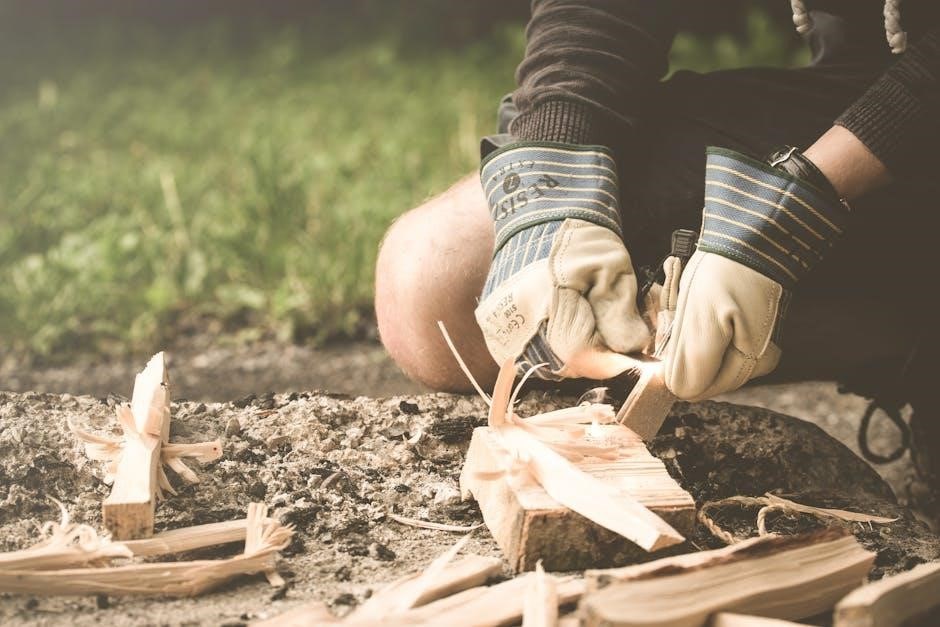A prepper survival guide provides essential strategies for emergencies, ensuring preparedness with supplies and skills to maintain self-reliance and safety in crisis situations․
Understanding the Importance of Preparedness

Preparedness is the cornerstone of survival, enabling individuals to respond effectively to emergencies․ Natural disasters, economic collapses, or personal crises can strike unpredictably, leaving the unprepared vulnerable․ A well-thought-out plan ensures access to essential resources like water, food, and medical supplies, reducing panic and increasing resilience․ Being prepared also fosters a mindset of self-reliance, empowering individuals to adapt and thrive during uncertain times․ It’s not about fear but about taking proactive steps to safeguard oneself and loved ones, ensuring safety and stability when chaos unfolds․
Key Principles of Prepping
The core of prepping lies in proactive planning and self-sufficiency․ It involves stockpiling essentials like food, water, and medical supplies while mastering skills to handle crises․ Adaptability is crucial, as situations can evolve unpredictably․ Preppers prioritize sustainability, ensuring resources last long-term․ Community building is also vital, as teamwork enhances survival chances․ Avoiding complacency and staying informed about potential threats are key; Ultimately, prepping is about being ready for the unexpected, ensuring safety and resilience through foresight and continuous learning․
Essential Supplies for Survival
Stockpile water, non-perishable food, first aid kits, and reliable shelter materials․ Include lighting, communication tools, and multi-tools for versatility in crisis situations․
Water Storage and Purification Methods
Storing clean water is critical for survival․ Use food-grade containers to hold at least one gallon per person daily․ Purification methods include water filters, UV treatment, or chemical tablets․ Boiling water at 100°C for one minute kills pathogens․ Consider portable filtration systems for long-term use․ Always rotate stored water every six months to ensure freshness․ Proper storage and purification ensure safe drinking water, preventing waterborne illnesses․ These practices are vital for maintaining health in emergency situations․
Food Supplies and Preservation Techniques
Stockpiling non-perishable food is essential for long-term survival․ Focus on high-calorie, nutrient-rich items like dried legumes, grains, and canned goods․ Proper preservation techniques, such as dehydration or vacuum-sealing, extend shelf life․ Rotate supplies every six months to ensure freshness․ Consider caching food in secure locations for emergency access․ Learn to cook with minimal resources, and maintain a balanced diet to sustain energy and health․ These strategies ensure food security during crises, keeping you nourished and prepared for the unexpected․
First Aid Kits and Medical Essentials
A well-stocked first aid kit is vital for treating injuries and preventing infections․ Include bandages, antiseptic wipes, pain relievers, and medical gloves․ Add prescription medications and essential medical tools like scissors and tweezers․ Consider a portable kit for easy access during emergencies․ Store supplies in a waterproof container to protect against moisture․ Regularly check expiration dates and restock as needed; A comprehensive first aid manual can guide you through basic medical procedures․ Ensuring you have these essentials can save lives and stabilize conditions until professional help arrives․
Shelter and Protection Gear
Secure shelter is critical for survival, protecting you from harsh weather and potential threats․ Invest in a durable, waterproof tent or tarpaulin for temporary housing․ Include sleeping bags, blankets, and ground pads for warmth․ Protective gear like helmets and bulletproof vests can safeguard against physical harm․ Consider portable fencing or barricade materials to secure your perimeter․ Store these items in an easily accessible location to ensure quick deployment during emergencies․ Regularly inspect and maintain your shelter gear to guarantee reliability when needed most․

Tools and Equipment for Survival
Essential tools include multi-tools, knives, and navigation aids like compasses and GPS devices․ Lighting sources such as flashlights and lanterns are vital, alongside power generation equipment like solar panels and portable chargers․ Weapons for self-defense, such as firearms or pepper spray, should also be considered to ensure safety in crisis situations․
Navigation Tools and Maps
Navigation tools and maps are critical for preppers to maintain orientation in unfamiliar or disaster-stricken areas․ A reliable compass, GPS devices, and detailed topographical maps are essential․ Paper maps are preferred over digital ones, as they don’t rely on battery power․ Orienteering skills, such as using the sun and stars for direction, can be lifesaving when modern tools fail․ Maps should highlight safe routes, water sources, and potential shelters․ Always include a backup navigation kit in your bug-out bag to ensure you can find your way to safety, even during a total grid collapse or natural disaster․
Lighting and Power Sources
Lighting and power sources are vital for preppers to maintain visibility and functionality during emergencies․ Flashlights, headlamps, and extra batteries are essentials, while solar-powered chargers and portable generators provide reliable energy․ LED candles and glow sticks offer low-energy alternatives for lighting․ Invest in energy-efficient options like rechargeable batteries and solar panels to ensure long-term sustainability․ A backup power supply, such as a portable battery bank, is crucial for charging communication devices․ Always include a mix of lighting options in your survival kit to navigate safely, signal for help, and power essential tools in off-grid situations․
Multi-Tool and Weapon Options
A multi-tool is a prepper’s best friend, offering versatility for various tasks like cutting, tightening, and opening․ Swiss Army knives and Leatherman tools are popular choices․ Weapons, such as firearms or pepper spray, provide self-defense capabilities․ When selecting weapons, consider legality, ease of use, and training requirements․ Always store weapons safely and ensure proficiency․ Alternative options like bats or improvised weapons can also be effective․ A multi-tool and weapon combination enhances your ability to handle unexpected challenges, ensuring you’re prepared for both utility and protection in survival situations․

Self-Defense and Security
Self-defense and security are vital for crisis survival․ Preppers should be prepared with firearms, alternative weapons, and strategies to secure shelters and maintain perimeter safety effectively․
Firearms and Ammunition
Firearms and ammunition are critical components of a prepper’s self-defense strategy․ Selecting reliable weapons, such as handguns or rifles, ensures protection in high-risk scenarios․ Ammunition should be stockpiled to withstand prolonged emergencies, with considerations for caliber compatibility and storage conditions․ Proper maintenance of firearms, including cleaning and lubrication, is essential for functionality․ Training in handling and safety is paramount to avoid accidents and ensure effective use․ Legal considerations, such as permits and storage laws, must also be adhered to․ A well-prepared arsenal enhances security and provides peace of mind during uncertain times․
Alternative Self-Defense Weapons
For preppers, alternative self-defense weapons offer practical options when firearms are unavailable․ Pepper spray, batons, and knives are non-lethal yet effective deterrents; Tasers provide incapacitation without deadly force․ These tools require minimal training and are easily portable․ They are ideal for close-quarters situations and can be used discreetly․ Additionally, everyday items like flashlights or walking sticks can be repurposed for defense․ These alternatives are indispensable in scenarios where firearms may be impractical or restricted․ Proper training ensures safe and effective use, making them essential components of a comprehensive self-defense plan․
Securing Your Shelter and Perimeter
Securing your shelter and perimeter is a critical aspect of prepping, ensuring safety and protecting resources․ Start by reinforcing doors and windows with sturdy materials like wood or metal․ Install surveillance cameras and motion-sensitive lighting to detect intruders․ Create barriers such as fences or berms to deter unauthorized access․ Consider setting up traps or alarms to alert you of potential threats․ Maintain a low profile to avoid attracting attention․ Regularly inspect your perimeter for vulnerabilities and adapt your security measures as needed․ A well-secured shelter and perimeter are your first line of defense in a crisis situation․
Communication in Crisis Situations
Effective communication is vital in crises, ensuring connectivity and coordination․ Use radios, two-way devices, or signaling tools like flares or mirrors to maintain contact and call for help․
Radio and Communication Devices
Reliable communication is crucial in survival situations․ Handheld radios, such as two-way walkie-talkies and HAM radios, are essential tools for staying connected with family and allies․ Look for devices with NOAA weather alerts, long battery life, and durability․ Solar-powered or crank radios offer sustainable options during power outages․ Preppers should also consider encrypted communication for security and invest in high-quality antennas for improved range․ When choosing a radio, prioritize ease of use, multiple frequency bands, and compatibility with other equipment․ Regularly test devices to ensure functionality and familiarize yourself with their operation before emergencies arise․
Signaling Techniques for Help
Effective signaling is vital for calling attention in survival situations․ Use fire or smoke during daylight to create visible signals, ensuring they are large enough to be seen from a distance․ Mirrors or shiny objects can reflect sunlight toward rescuers, while flares or bright clothing can attract attention․ Always follow universal signaling patterns, such as creating “X” or “HELP” marks on the ground․ Stay visible by choosing open areas and using high-contrast materials․ Practice these techniques beforehand to ensure quick and clear communication, maximizing your chances of being noticed and rescued efficiently in emergencies․
Maintaining Privacy and Security in Communication
Maintaining privacy and security in communication is crucial for preppers to avoid detection and protect sensitive information․ Use encrypted communication tools and secure channels to ensure messages remain confidential․ Avoid sharing unnecessary details that could compromise your location or plans․ Employ low-tech methods, such as face-to-face meetings or written notes, to minimize digital footprints․ Regularly monitor for surveillance and use anonymity tools like VPNs or secure messaging apps․ Always verify the identity of contacts and be cautious of unknown sources․ By prioritizing communication security, you safeguard your operations and ensure a higher level of personal and group safety in emergencies․

Creating a Bug-Out Bag
A bug-out bag is a portable kit containing essential supplies for at least 72 hours, customized to meet individual or family needs, ensuring readiness for quick escapes during emergencies․
Essential Items to Include
Your bug-out bag should include water (at least 1 gallon per person per day), non-perishable food, a first aid kit, shelter materials like a tent or tarp, and navigation tools such as a compass or GPS․ Lighting sources like flashlights or glow sticks, a multi-tool or knife, and self-defense items like a firearm or pepper spray are crucial․ Communication devices, extra clothing, and personal hygiene items should also be packed․ Don’t forget important documents, a whistle for signaling, and a checklist to ensure nothing is missed․ Customize the contents based on your family’s needs and the potential disasters in your area․
Clothing and Personal Gear
Pack durable, weather-appropriate clothing, including moisture-wicking base layers, insulating mid-layers, and waterproof outerwear․ Sturdy footwear, gloves, and hats are essential for varying conditions․ Include extra socks, underwear, and a change of clothes in case of unexpected delays․ Personal gear should feature lightweight, quick-drying materials․ Don’t forget a sleeping bag or emergency blanket for warmth․ Customize your clothing selection based on your climate and potential scenarios․ Ensure all items are versatile, space-efficient, and tailored to your family’s needs for maximum comfort and practicality during a crisis․
Checklist for Bug-Out Bag Preparation
A well-prepared bug-out bag requires careful organization․ Start with essential supplies: water (at least 3 liters per person), non-perishable food, and a first aid kit․ Include shelter gear like a tent, tarp, or emergency blanket․ Add communication tools such as a portable radio and whistle․ Don’t forget multi-tools, flashlights, and extra batteries․ Pack extra clothing, sturdy footwear, and personal hygiene items․ Include important documents like IDs, cash, and maps․ Regularly review and update your bag to ensure all items are usable and relevant․ Customize the checklist based on your family’s needs and potential disaster scenarios․

Mental and Physical Preparedness
Mental and physical preparedness is crucial for survival, ensuring resilience and focus during crises․ Staying calm, engaging in physical training, and maintaining a positive mindset are essential for self-reliance and effective decision-making․
Staying Calm and Focused in Emergencies
Staying calm and focused in emergencies is vital for making rational decisions and ensuring survival․ Panic can cloud judgment, leading to poor choices․ Techniques like deep breathing, mental exercises, and positive visualization help maintain composure․ Practicing these methods beforehand builds resilience․ In a crisis, prioritize clear thinking and logical decision-making․ Avoid overloading with unnecessary tasks and focus on immediate needs․ Training the mind to remain steady under pressure enhances overall preparedness and improves the ability to navigate challenging situations effectively․
Physical Training for Survival Situations
Physical training is crucial for survival, enhancing strength, endurance, and mobility․ Regular exercises like weight training, cardio, and flexibility routines improve stamina and overall resilience․ Practicing activities such as hiking, swimming, and self-defense prepares you for real-world challenges․ Building muscle and endurance ensures you can carry supplies, navigate terrains, and sustain energy over time․ A strong body supports mental stamina, helping you stay focused and determined in crises․ Incorporate physical conditioning into your daily routine to build the physical and mental fortitude needed for survival situations․
Maintaining a Positive Mindset
Maintaining a positive mindset is vital for survival, as it fosters resilience and adaptability in challenging situations․ Cultivating optimism helps individuals stay motivated and focused, enabling better decision-making under stress․ Techniques such as mindfulness, visualization, and gratitude can enhance mental fortitude․ A positive outlook encourages problem-solving creativity and strengthens interpersonal connections, crucial for group survival efforts․ By embracing a proactive attitude, preppers can navigate adversity with confidence and perseverance, ultimately increasing their likelihood of thriving during crises․

Advanced Survival Techniques
Advanced survival techniques involve mastering sustainable practices, self-sufficiency, and off-grid energy solutions to ensure long-term preparedness and adaptability in challenging environments․
Building a Long-Term Survival Plan
Building a long-term survival plan involves creating a detailed strategy for sustained preparedness, focusing on sustainable resources, renewable energy, and self-sufficient practices․ Assess your needs, set clear goals, and prioritize essential supplies like water, food, and medical equipment․ Incorporate skills such as farming, animal husbandry, and off-grid energy solutions to ensure independence․ Regularly review and adapt your plan to address evolving challenges and maintain readiness for extended crises․ A well-structured plan enhances resilience, ensuring you and your family can thrive in uncertain conditions․ Preparation is key to securing a stable future․
Farming and Animal Husbandry Basics
Farming and animal husbandry are cornerstone skills for long-term survival, ensuring a sustainable food supply․ Start by selecting crops suited to your climate and soil type, focusing on hearty, high-yield varieties․ Learn soil preparation, irrigation, and pest control techniques to maximize productivity․ For animal husbandry, choose hardy species that provide milk, eggs, or meat․ Understand feeding, breeding, and health management to maintain a thriving flock or herd; These practices not only provide food but also foster self-reliance, enabling you to sustain your household independently․ Mastering these basics is essential for a resilient survival plan․
Foraging and Wild Edibles
Foraging for wild edibles is a critical survival skill, providing fresh nutrients when supplies are scarce․ Learn to identify edible plants like dandelion, wild berries, and mushrooms, ensuring they are safe to consume․ Avoid toxic lookalikes by studying detailed field guides or seeking expert guidance․ Practice sustainable foraging to preserve ecosystems and ensure future resources․ Always avoid areas contaminated by pollutants or pesticides․ Mastering this skill enhances self-reliance and ensures access to food in remote or off-grid environments, making it a vital component of any prepper survival strategy․
Off-Grid Energy Solutions
Off-grid energy solutions are essential for sustainable living during crises․ Solar panels, wind turbines, and hydroelectric systems provide reliable power without reliance on public utilities․ Portable options like solar chargers and battery banks offer flexibility for mobile scenarios․ Energy storage systems, such as deep-cycle batteries, ensure power availability during low-generation periods․ Consider generators as backup options for emergencies․ Always prioritize energy efficiency by using LED lighting and low-power appliances․ These solutions enable preppers to maintain essential systems and comforts, ensuring independence and resilience in off-grid environments․ Proper planning and maintenance are key to maximizing their effectiveness․
